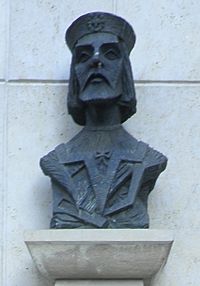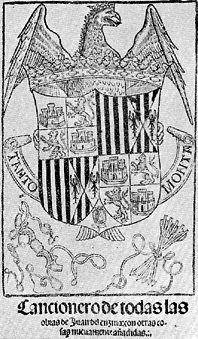Juan del Encina facts for kids
Quick facts for kids
Juan del Encina
|
|
|---|---|

Bust of Juan del Enzina in León
|
|
| Born | July 12, 1468 possibly Fermoselle, Encina de San Silvestre or La Encina, Castile |
| Died | 1529 (aged 60–61) Toledo, Spain |
| Occupation | Playwright, poet, musician |
| Nationality | Castilian, Spanish |
| Alma mater | University of Salamanca |
| Subject | Religion |
| Literary movement | Renaissance humanism Spanish Renaissance |
| Notable works | Cancionero, Égloga de Plácida y Vitoriano |
Juan del Encina (born July 12, 1468 – died around 1529 or 1530) was a very important Spanish composer, poet, and playwright. Many people call him one of the founders of Spanish theater. His original name was Juan de Fermoselle. He sometimes spelled his last name "Enzina," but it's the same sound. Back then, spelling rules were not as strict as they are today!
Contents
His Life Story
Juan del Encina was born in 1468 near a city called Salamanca in Spain. He was one of at least seven children. His father was a shoemaker. Juan came from a family with Jewish roots who had converted to Christianity.
After studying at Salamanca University, he started working for Don Fadrique de Toledo, who was the Duke of Alba. This was around 1492 or 1495. Some people think his first job might have been as a local official in northern Spain.
Name Change and Early Career
In the early 1490s, Juan was a Chaplain at the Salamanca Cathedral. During this time, he changed his name from Juan de Fermoselle to Juan del Encina. "Encina" means "holm oak," which is a type of tree. He later had to leave his job as Chaplain because he had not been officially ordained as a priest.
His Amazing Works
In 1492, Juan del Encina wrote a play called Triunfo de la fama. He wrote it to celebrate the fall of Granada, a big event in Spanish history. In 1496, he published his famous book, the Cancionero. This book was a collection of his dramatic plays and lyrical poems.
He tried to get a job as a lead singer at Salamanca Cathedral. However, the position was split among three singers, and one of them was his rival, Lucas Fernandez.
Plays and Music
While working for the Duke of Alba, Encina helped direct performances. Here, he wrote special plays called pastoral eclogues. These plays are often seen as the start of Spanish non-religious drama. Encina's plays usually featured shepherds and stories about unreturned love.
Juan del Encina was very ambitious. Around 1500, he moved to Rome, hoping to get better jobs. He worked for several important cardinals or noblemen there. In 1508, he was appointed to a high church position in Malaga Cathedral.
In 1518, he left his job in Malaga. The next year, he went on a pilgrimage to Jerusalem, a very important religious journey. He even sang his first mass (a church service) there. He wrote a book about his journey called Tribagia o Via Sacra de Hierusalem.
Later, in 1519, he became the head priest (prior) of Leon Cathedral. He worked there until he became ill in December 1529. He is thought to have died around late 1529 or early 1530.
His Legacy
His Cancionero book starts with a section about how poetry was written in Spain at the time. His fourteen plays show how Spanish theater changed from being only about religious topics to including more everyday stories. For example, Aucto del Repelón and Égloga de Fileno are about shepherds.
Even though his plays might seem simple now, they were very important for the history of theater. His non-religious plays created a new style. His religious plays helped prepare the way for the "autos," which were popular religious plays in the 1600s. Encina's lyrical poems are also known for being very heartfelt and graceful.
Interestingly, even though he wrote for royal families, he never worked directly for a royal chapel. He also worked in many cathedrals and was a priest, but we don't have any of his religious music today. Most of his known works were created by the time he was in his mid-30s. He wrote about 60 or more songs. Many of his surviving pieces are villancicos, which are a type of Spanish song similar to Italian frottola. He was a leading composer of these songs.
His songs often had three or four voices and used different styles depending on the words. He used flexible rhythms to make the words clear and simple, strong musical patterns.
Time in León
Juan del Encina was the head priest of Leon Cathedral from November 1523 until his final illness in December 1529. His will was presented on January 14, 1530, so we don't know his exact death date. In his will, he asked to be buried in Salamanca Cathedral. In 1534, his remains were moved there.
Language Influence
Juan del Encina wrote in Castilian Spanish. However, his plays about shepherds also show influences from the Leonese language. This is because he was from Salamanca, a region where Leonese was spoken. He also died in León, which was once the capital of the old Kingdom of León.
He also wrote songs for the church.
Selected Works
Here are some of Juan del Encina's most famous works:
- Una sañosa porfía (1486)
- Triunfo de la fama (1492)
- Cancionero (1496)
- Tan buen ganadico (1496)
- Más vale trocar (1496)
- Triste España sin ventura (1504)
- Plácida y Victoriano (1513)
- Églogas (a collection of plays)
- Oy comamos y bebamos (late 15th century)
- Tribagia o Via Sacra de Hierusalem (1521)
His Music Today
Juan del Encina's music is still performed and enjoyed by many groups today! His works have been recorded and shared by various musical ensembles over the years. These performances help keep his amazing music alive for new generations to hear.
Recordings
- 2021: Todos los bienes del mundo: Juan del Encina and Musical Traits in Spanish Renaissance — ContrArco Consort (Da Vinci C00526)
See also
 In Spanish: Juan del Encina para niños
In Spanish: Juan del Encina para niños


